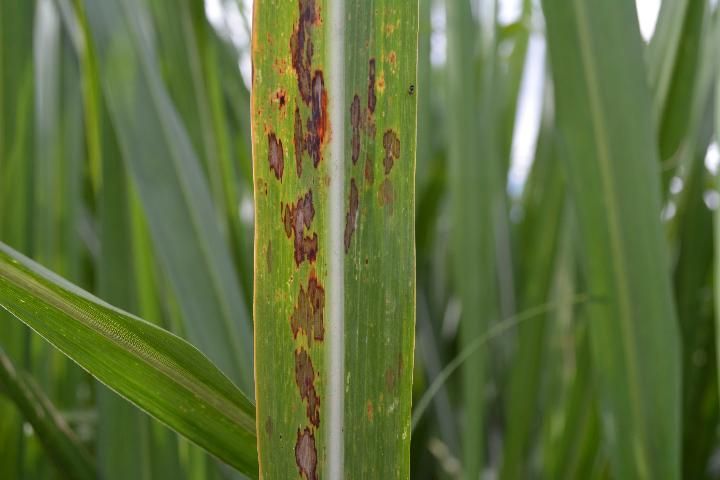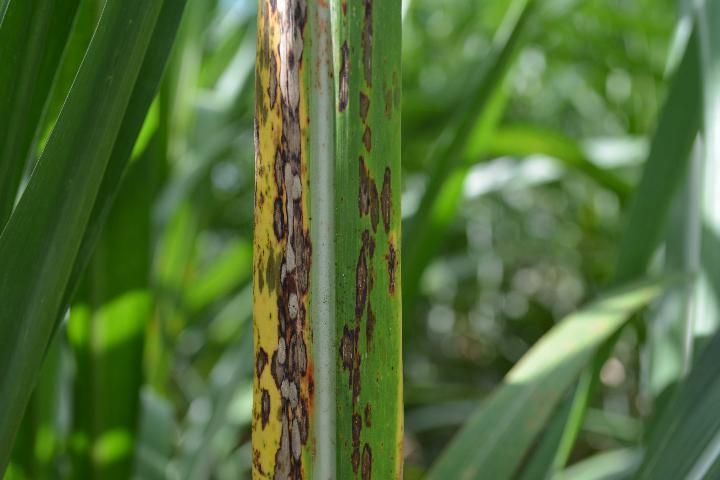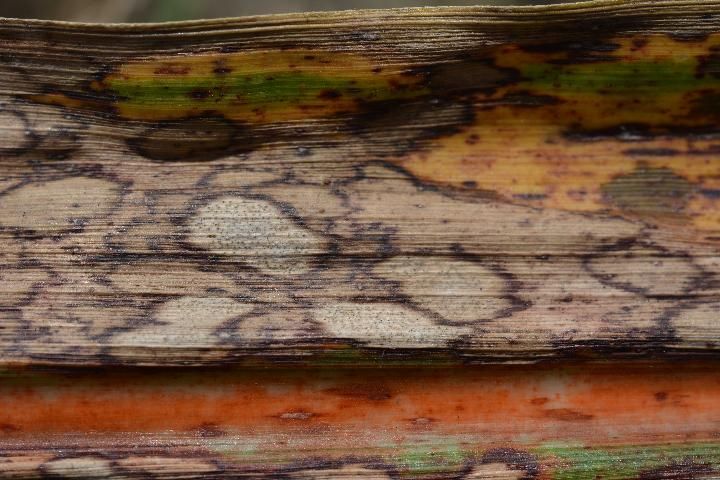Ring spot, caused by the fungus Leptosphaeria sacchari, is a disease of sugarcane that has been known to occur in Florida for over 80 years. A hurricane in September 1928 apparently brought it to Florida from Puerto Rico (Bourne 1930). Ring spot is a common disease in all sugarcane growing locations in the world and can be frequently observed in germplasm collections or commercial fields. However, because it generally affects only the senescing leaves, it is considered a minor disease of no economic importance. Correct identification of this disease in the field can help growers avoid unnecessary chemical sprays.
Symptoms
Initial symptoms of ring spot are small, elongated, oval-shaped spots that are dark olivaceous green to reddish-brown with narrow yellow halos (Bourne 1934; Croft 2000). These spots can be confused with those of other diseases such as eye spot, which is caused by Bipolaris sacchari (Rott et al. 2014), or brown stripe of sugarcane, which is caused by Bipolaris stenospila (Whittle 2000). Typical older symptoms of ring spot are large and elongated lesions (2.5 to 5 mm x 10 to 18 mm) with irregular outlines and red-brown margins (Figures 1 and 2). The center of these lesions is dark olivaceous green to straw-brown in color. These spots may coalesce and form patches which result in leaf chlorosis and necrosis (Figure 2). Spots may sometimes occur on the leaf sheath and the stem (Bourne 1934), but older leaf blades are usually the most affected part of the plant. Symptoms of ring spot can also be confused with the symptoms of herbicide damage. Small, black fruiting bodies of the fungal pathogen may be seen in older ring spot lesions (Figure 3); these are diagnostic criteria for the disease in the field.

Credit: Philippe Rott, UF/IFAS

Credit: Philippe Rott, UF/IFAS

Credit: Philippe Rott, UF/IFAS
Ring spot is caused by the fungus Leptosphaeria sacchari, and sugarcane is the only host known for this pathogen.
Spread of the Disease
Ring spot is spread by wind or rain-born spores of the fungus.
Prevention and Control
Little is known about the influence of ring spot on yield, but it is generally assumed to be minor since the disease is usually heaviest in the lower canopy. Disease control measures of sugarcane are therefore aimed at diseases known to be more influential, such as brown rust (Puccinia melanocephala), orange rust (Puccinia kuehnii), smut (Sporisorium scitamineum), mosaic (Sugarcane mosaic virus and Sorghum mosaic virus), ratoon stunt (Leifsonia xyli subsp. xyli), and leaf scald (Xanthomonas albilineans). In Florida, new sugarcane cultivars (CP cultivars) are produced in the frame of a tripartite program between University of Florida (Everglades Research and Education Center at Belle Glade), USDA-ARS (Sugarcane Field Station at Canal Point), and the Florida Sugarcane League (Sandhu et al. 2014). Promising genotypes in this CP sugarcane cultivar development program are examined for ring spot resistance in later developmental stages. Any genotype showing high susceptibility to ring spot in addition to some susceptibility to rust (P. melanocephala or P. kuehnii) or smut (S. scitamineum) is discarded. This has led to a good general level of resistance within most of the Florida sugarcane cultivars, but differences in susceptibility are frequently observed in production. Calcium silicate slag, as a soil amendment, has also been found to have a significant positive impact on yield, as well as reducing ring spot severity; it is frequently used in Florida sugarcane production (Raid et al. 1991). This helps to lessen any impact that this disease might have.
References
Bourne, B. A. 1930. "The occurrence of the ring-spot disease of sugar-cane in Florida." Phytopathology 20(4):364–365.
Bourne, B. A. 1934. Studies on the Ring Spot Disease of Sugarcane. Bulletin 267. Gainesville: University of Florida Institute of Food and Agricultural Sciences. http://ufdc.ufl.edu/UF00027204/00001/
Croft, B. J. 2000. "Ring spot". In A Guide to Sugarcane Diseases, edited by Philippe Rott, Roger A. Bailey, Jack C. Comstock, Barry J. Croft, and A. Salem Saumtally, 167–69. Montpellier, France: CIRAD/ISSCT, La Librairie du Cirad.
Raid, R. N., D. L. Anderson, and M. F. Ulloa. 1991. "Influence of cultivar and amendment of soil with calcium silicate slag on foliar disease development and yield of sugarcane." Crop Protection 11:84–88.
Rott, P., J. C. Comstock, R. A. Gilbert, and H. S. Sandhu. 2014. Sugarcane Eyespot Disease. SSAGR203. Gainesville: University of Florida Institute of Food and Agricultural Sciences. https://edis.ifas.ufl.edu/sc003
Sandhu, H. S., B. Glaz, S. J. Edmé, R. W. Davidson, D. Zhao, J. C. Comstock, R. A. Gilbert, S. B. Milligan, C.-J. Hu, N. C. Glynn, S. Sood, and K. McCorkle. 2014. "Registration of 'CPCL 02-6848' sugarcane." Journal of Plant Registrations 8:155–161.
Whittle, P. J. L. 2000. "Brown stripe". In A Guide to Sugarcane Diseases, edited by Philippe Rott, Roger A. Bailey, Jack C. Comstock, Barry J. Croft, and A. Salem Saumtally, 81–84. Montpellier, France: CIRAD/ISSCT, La Librairie du Cirad.